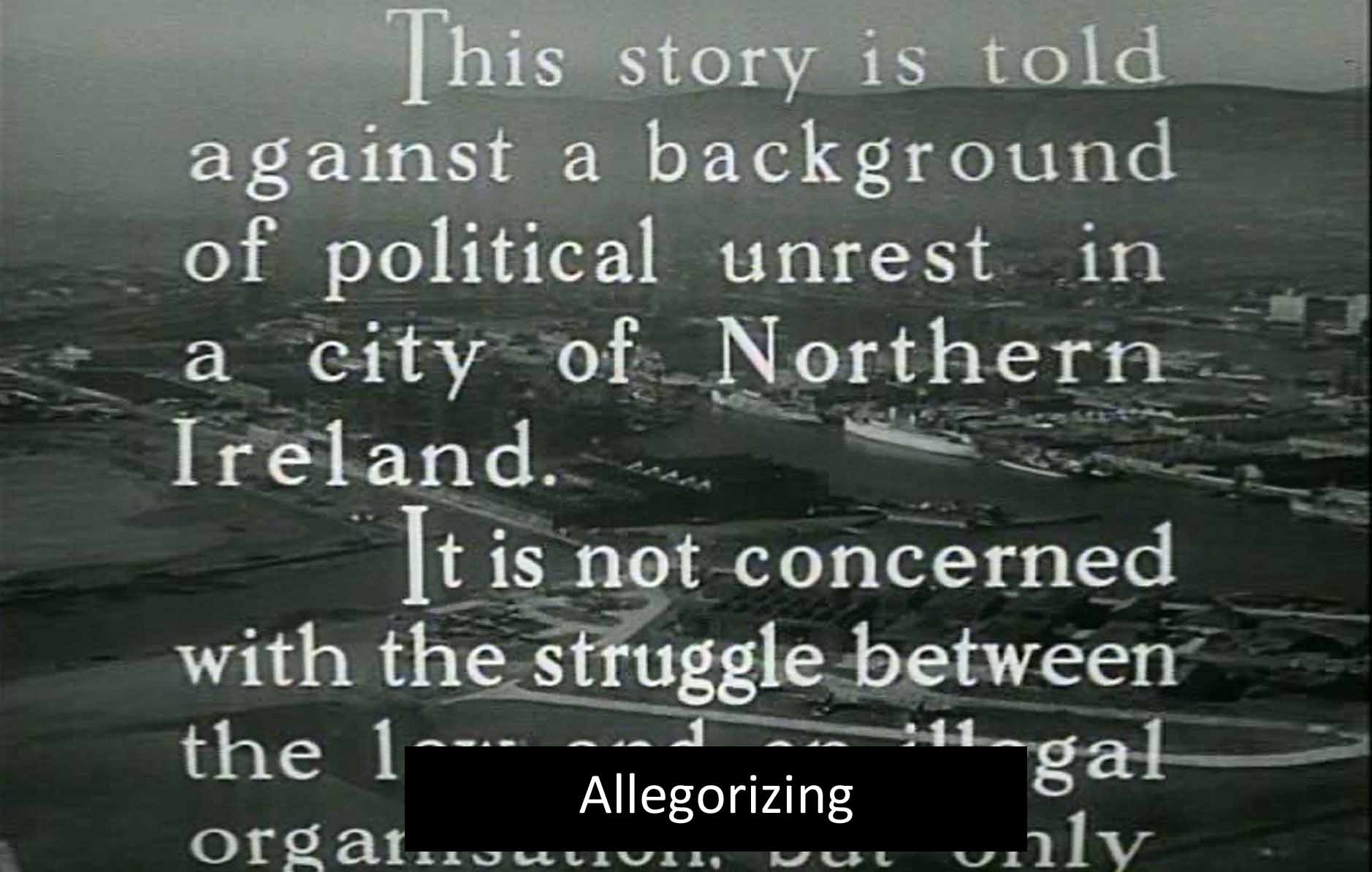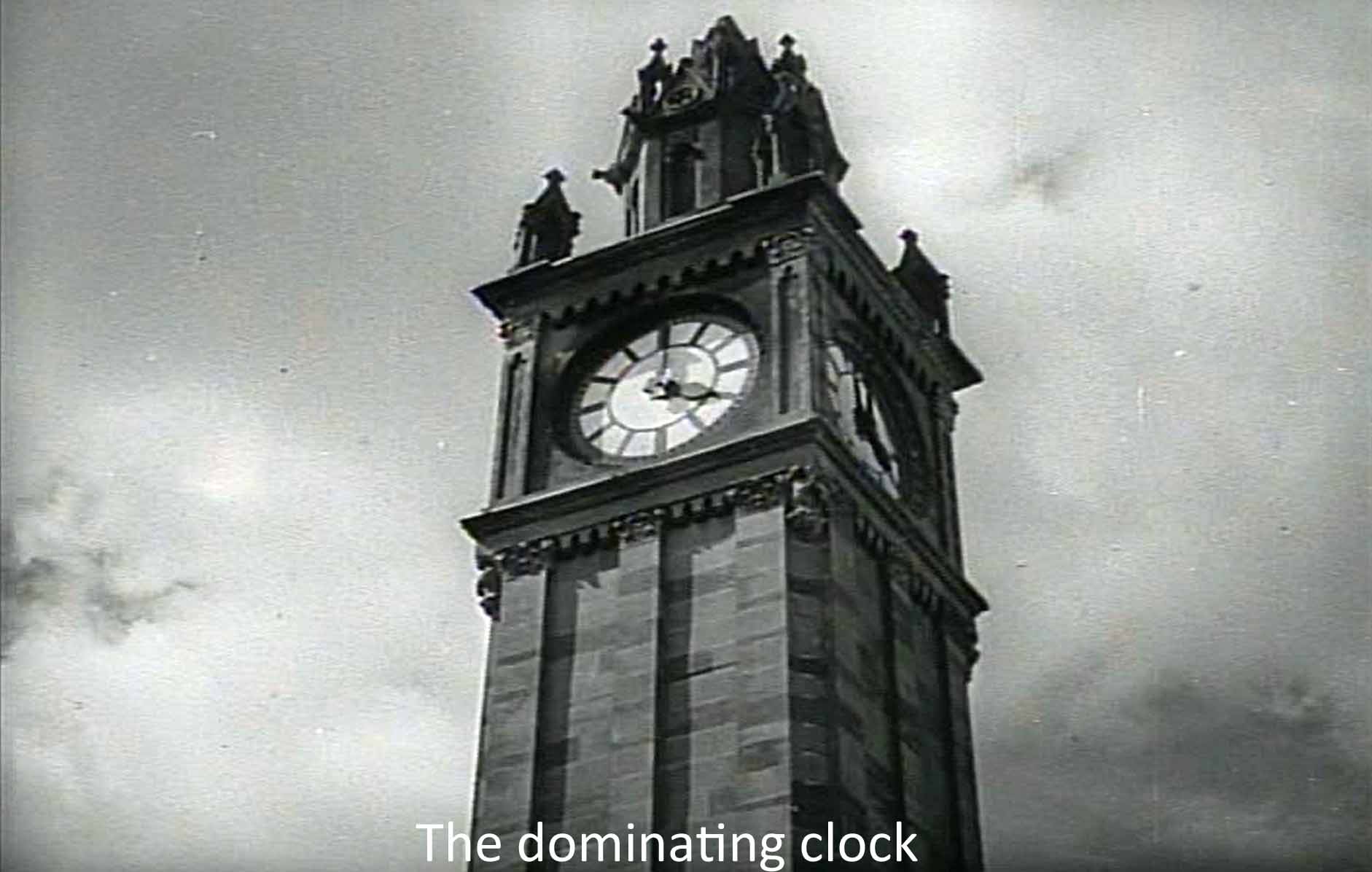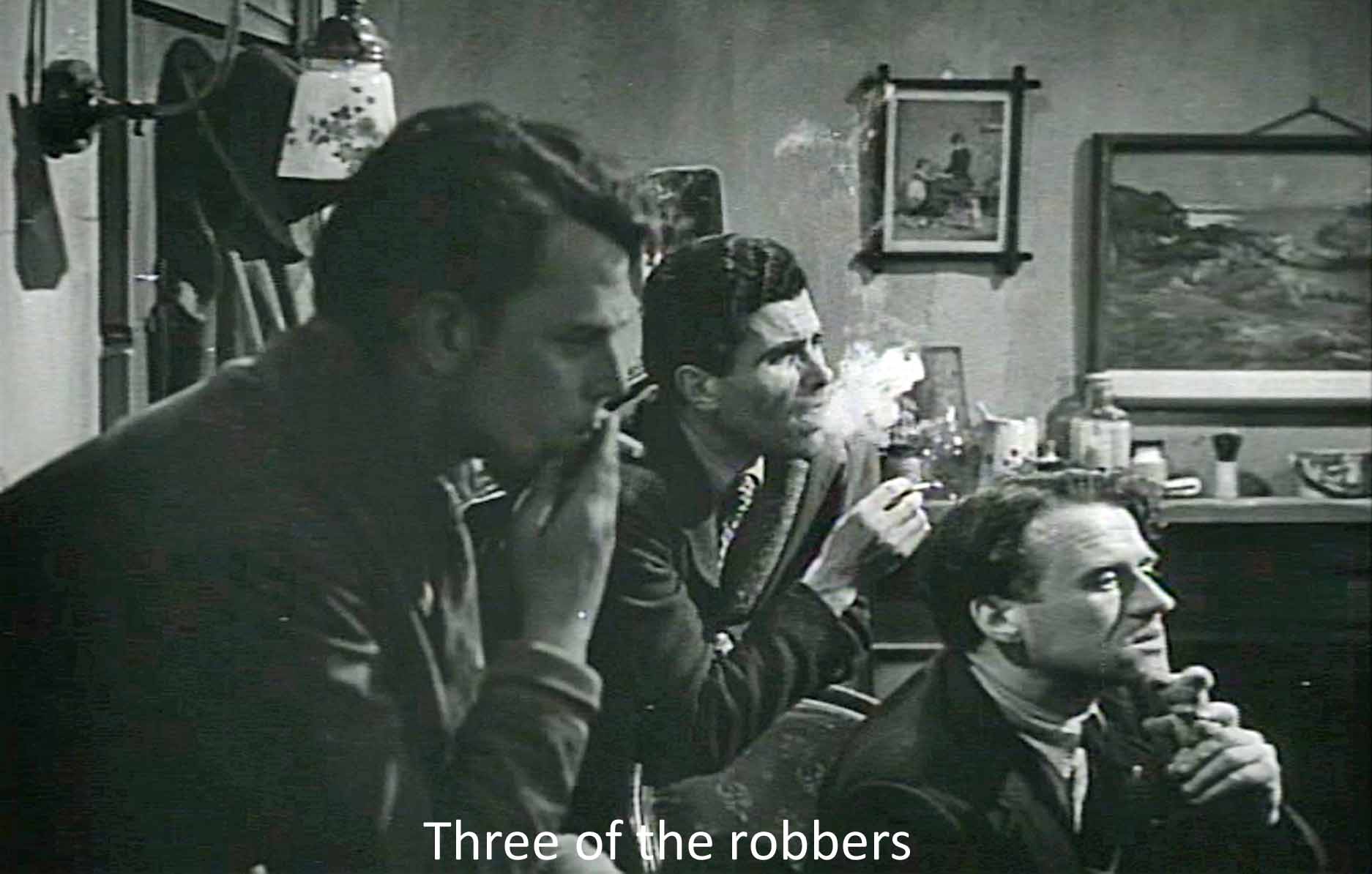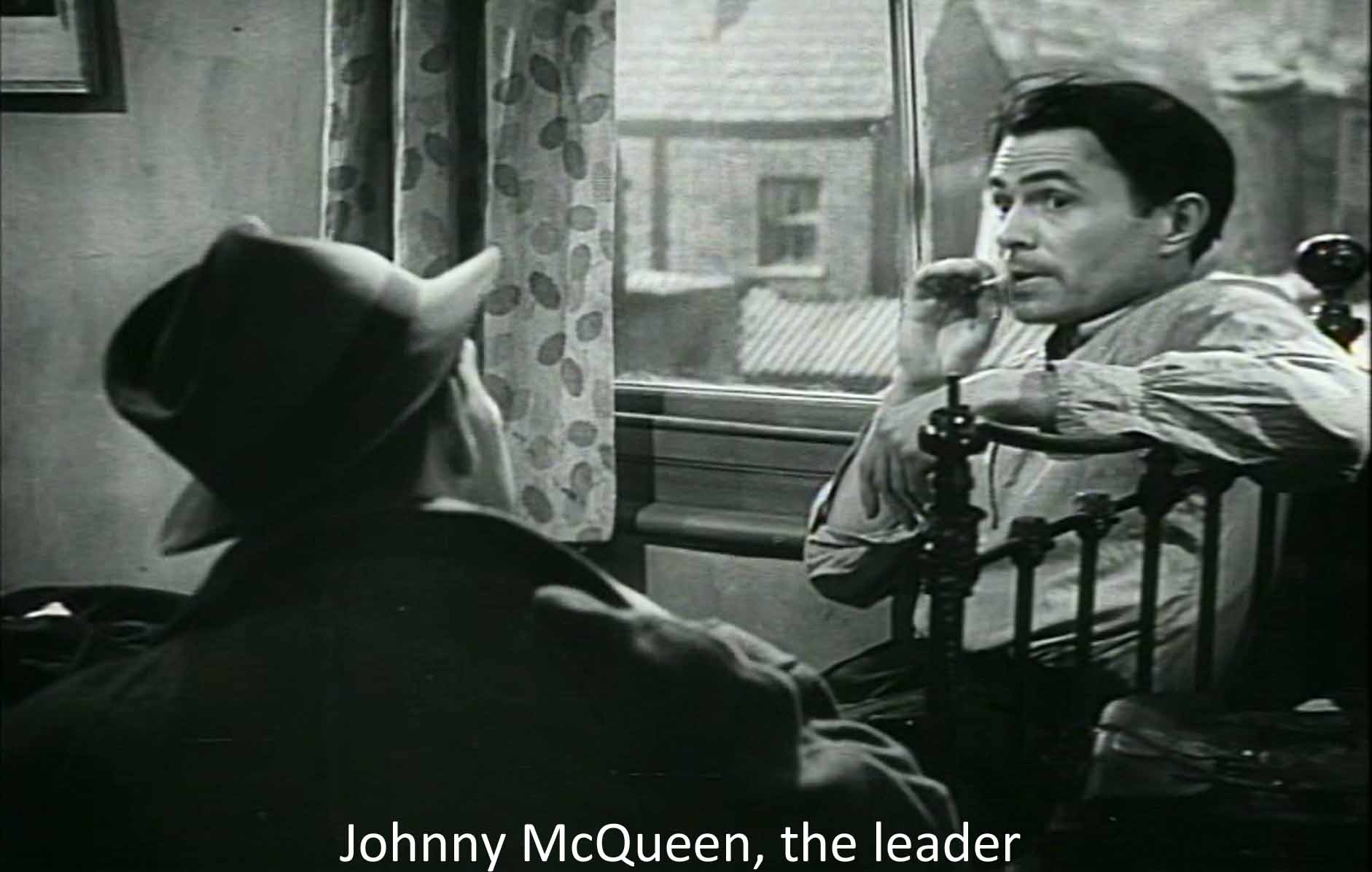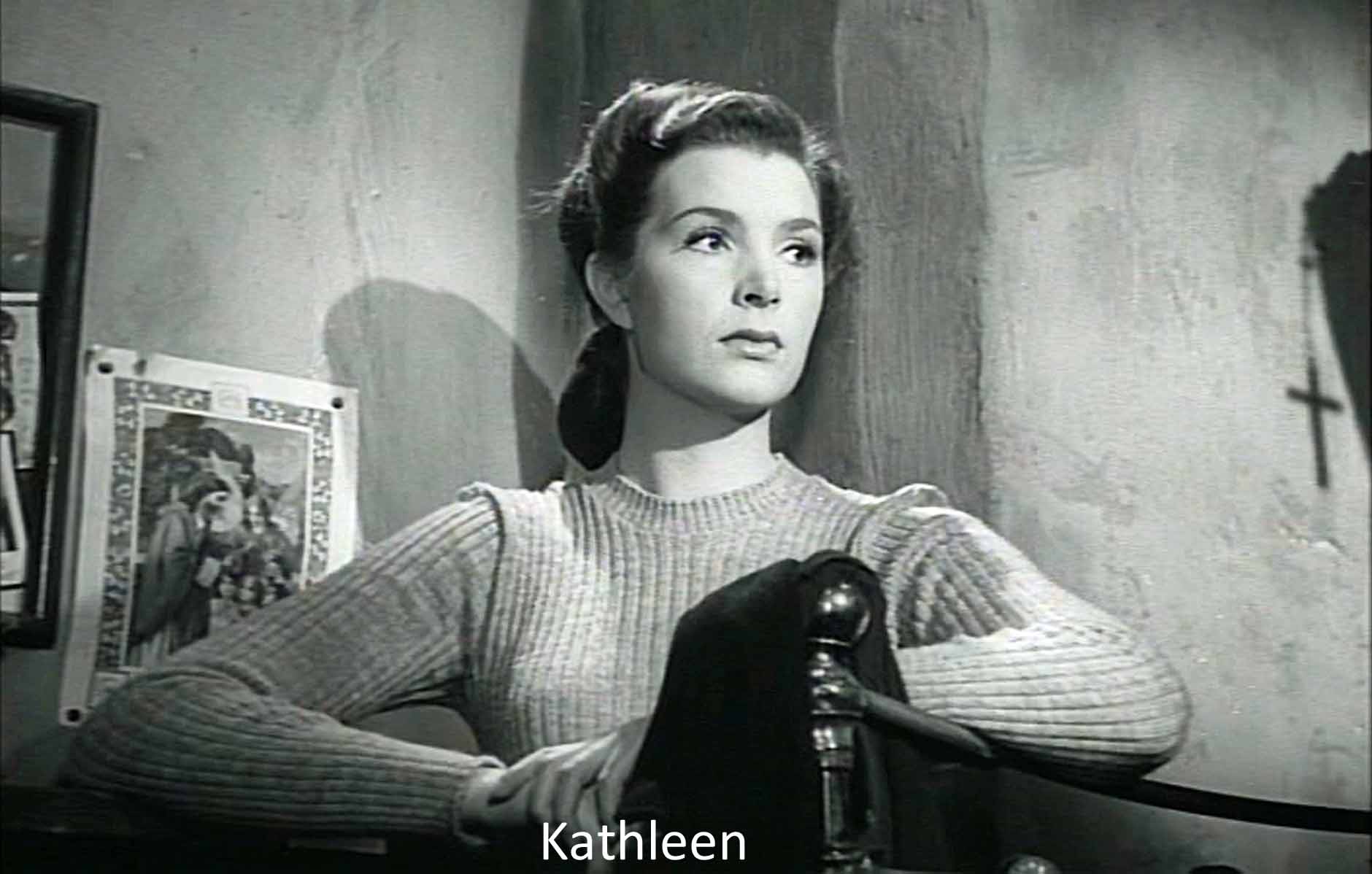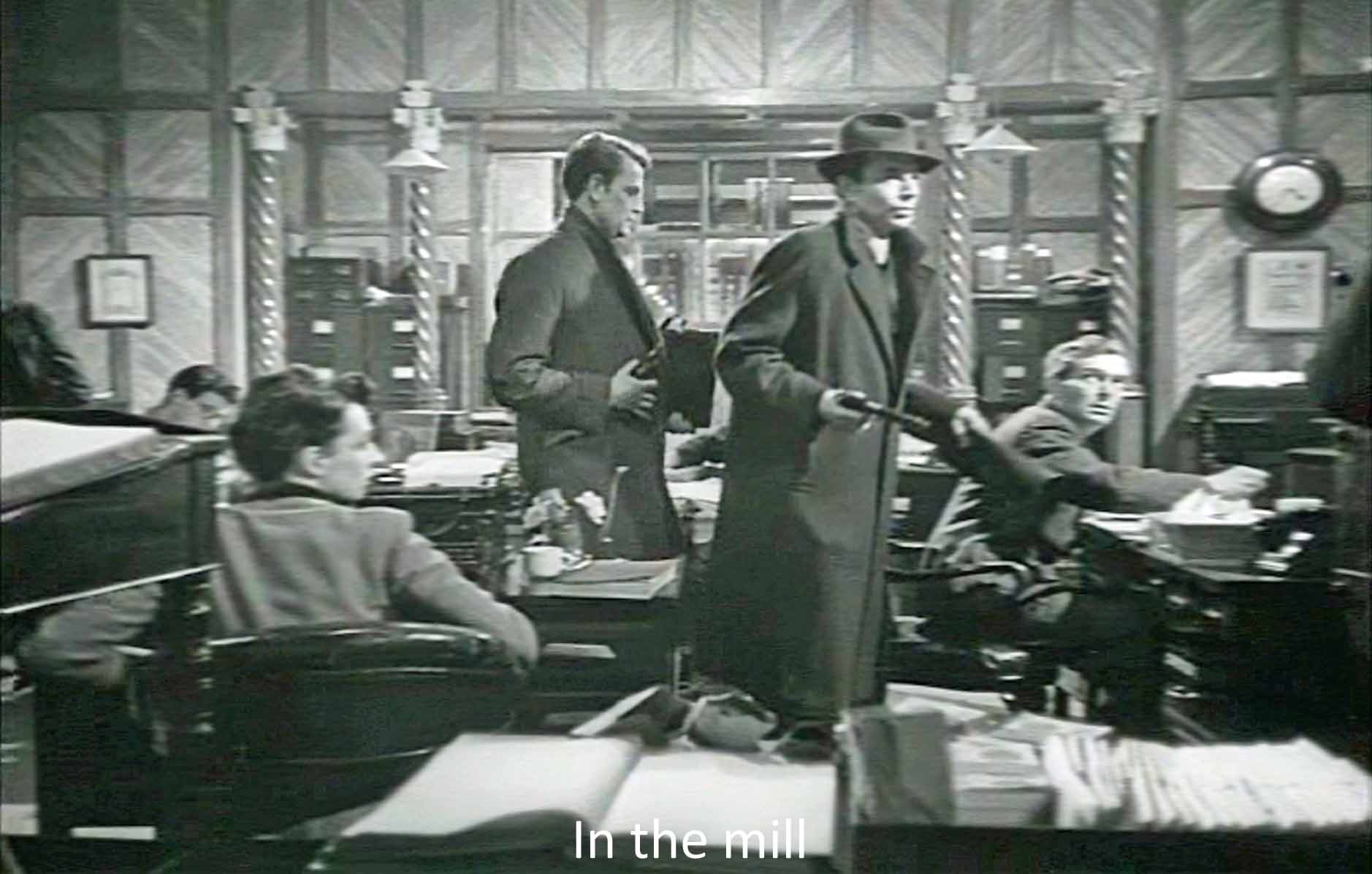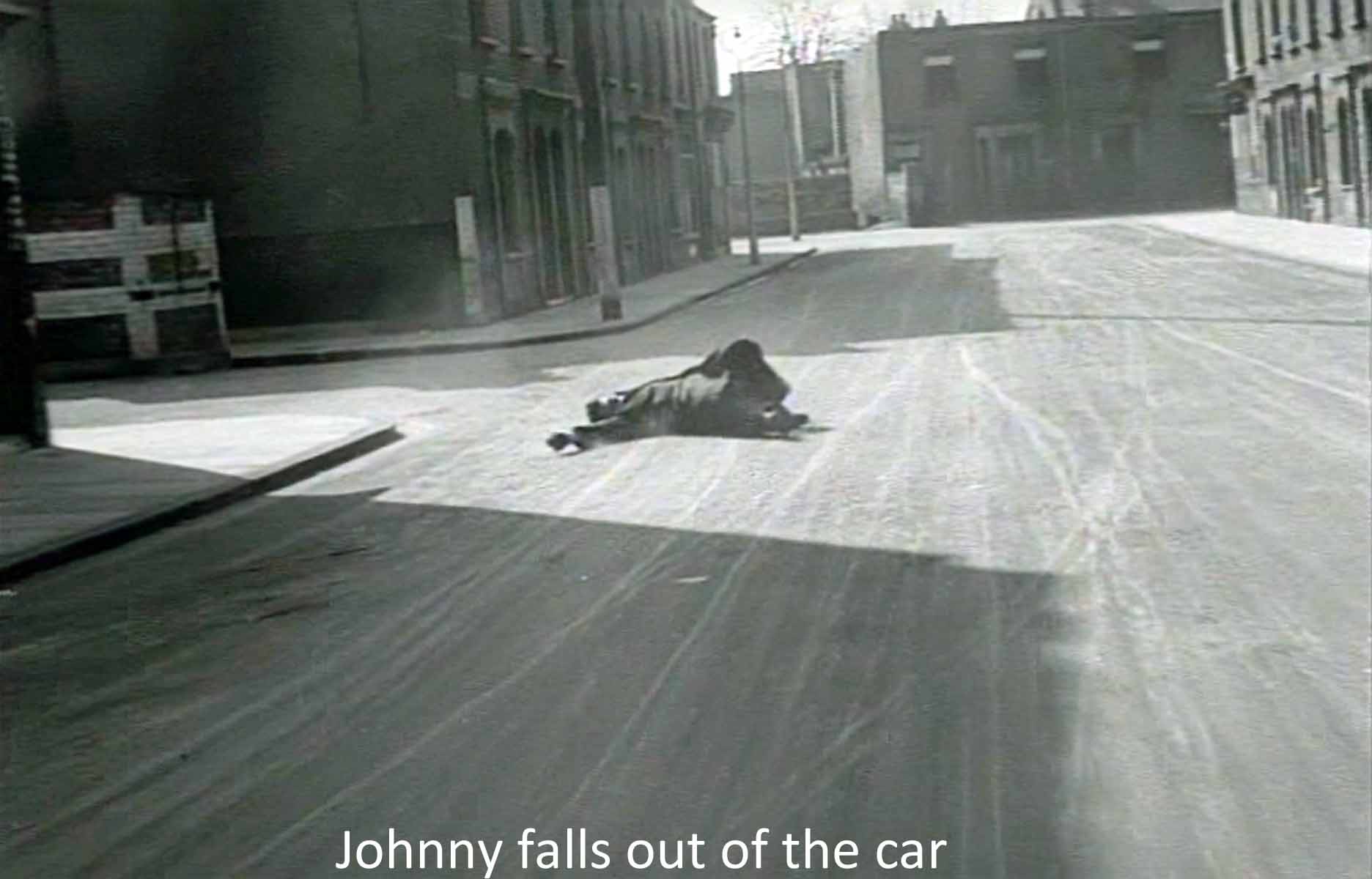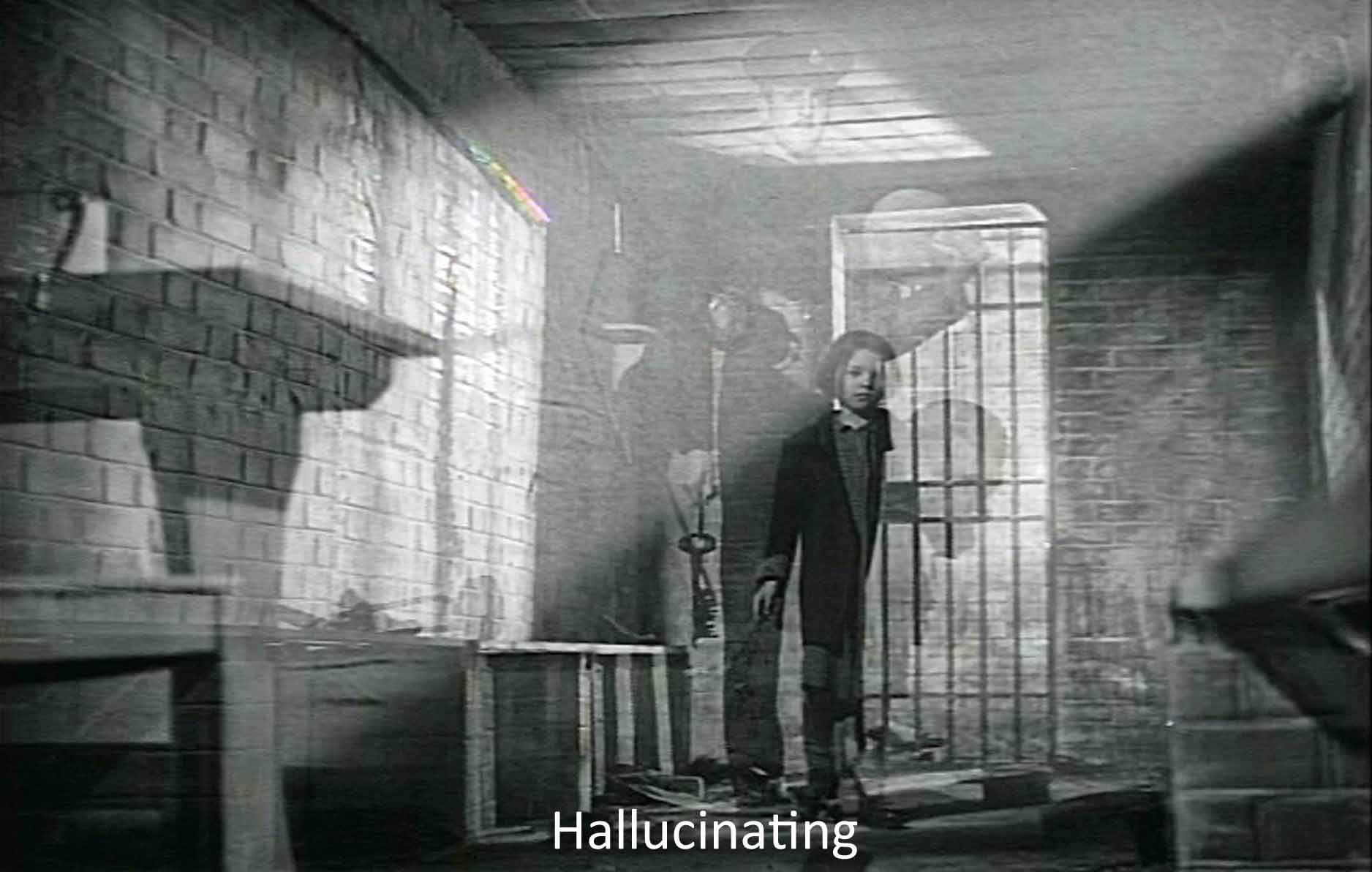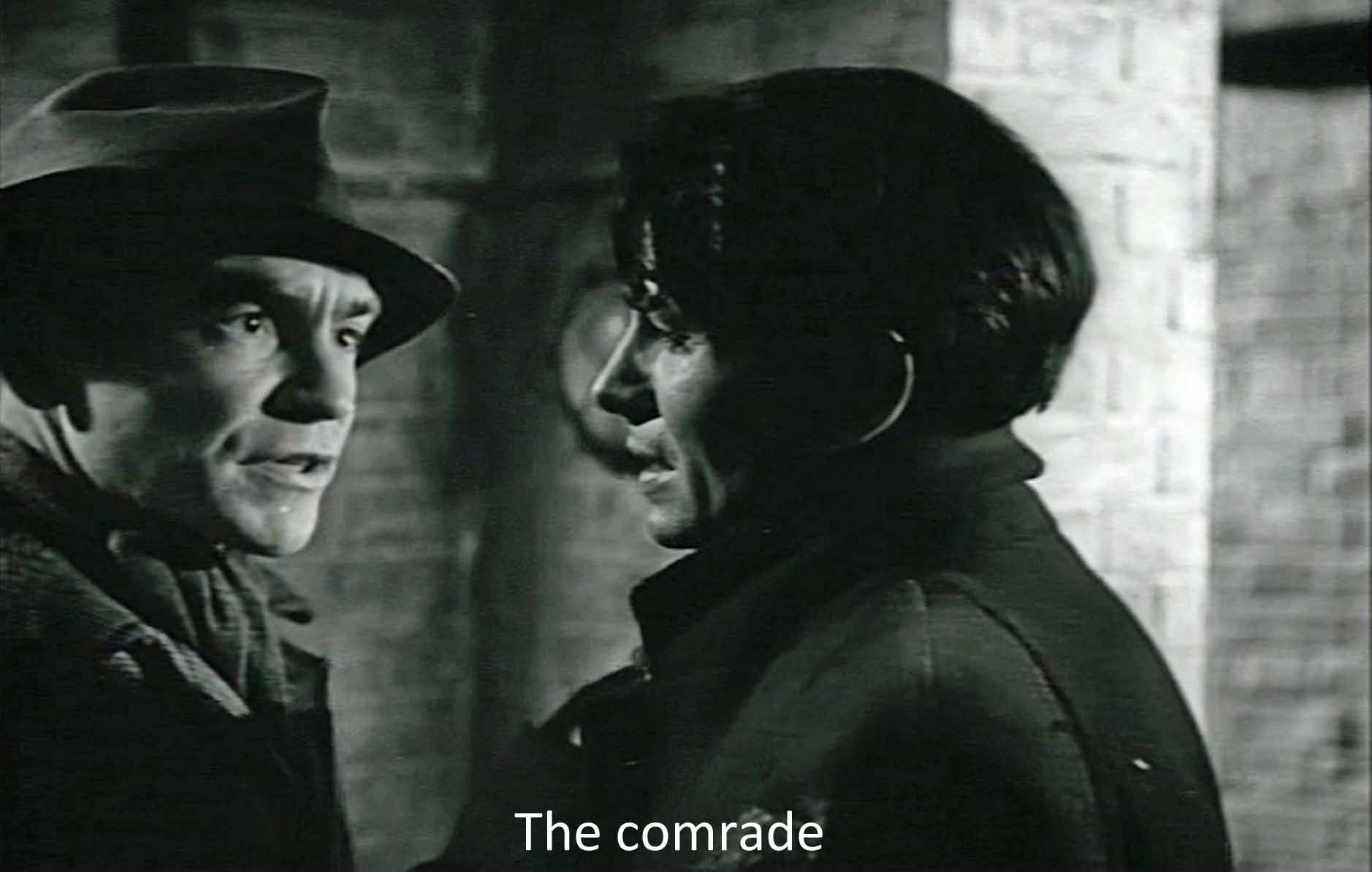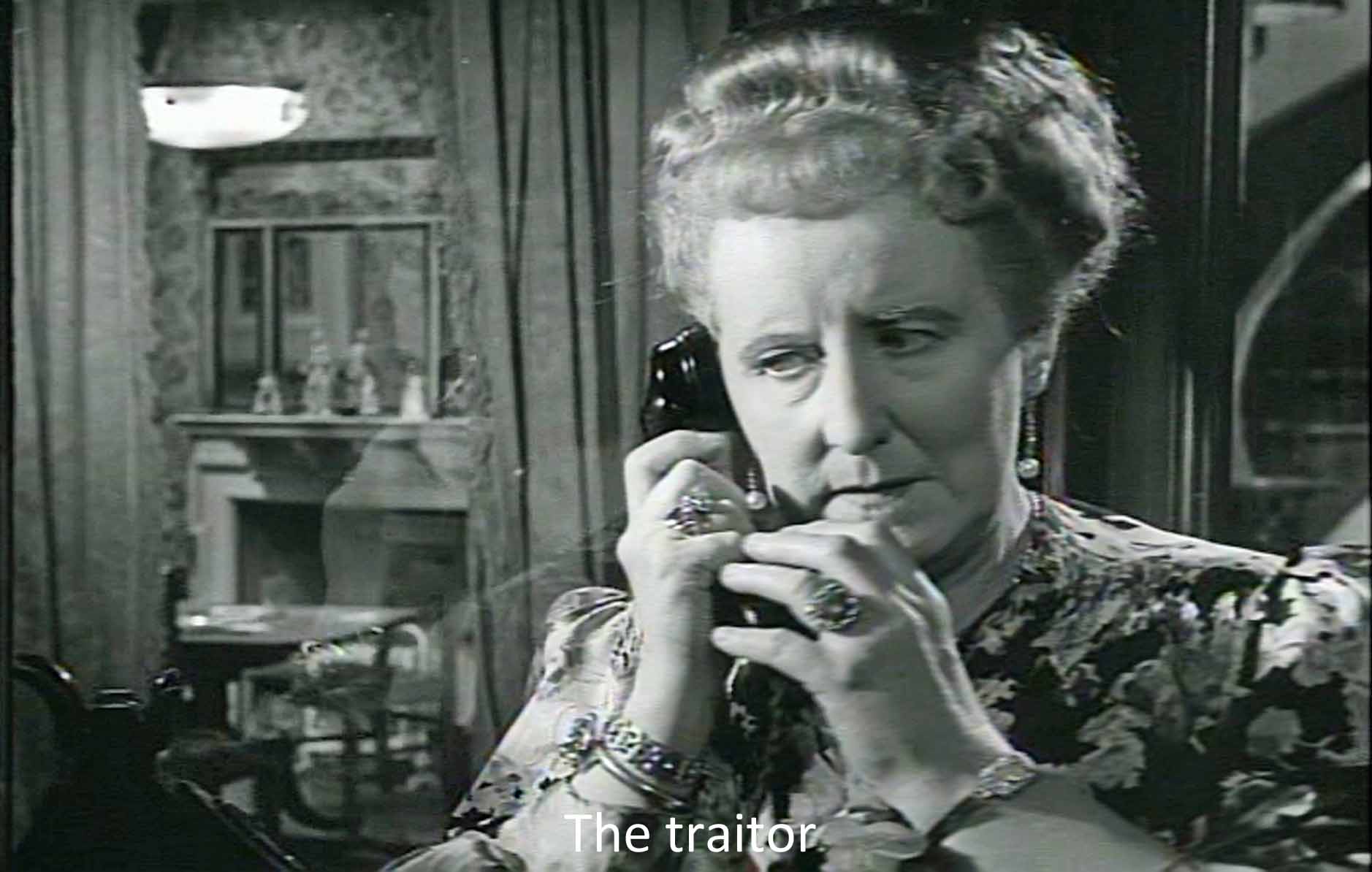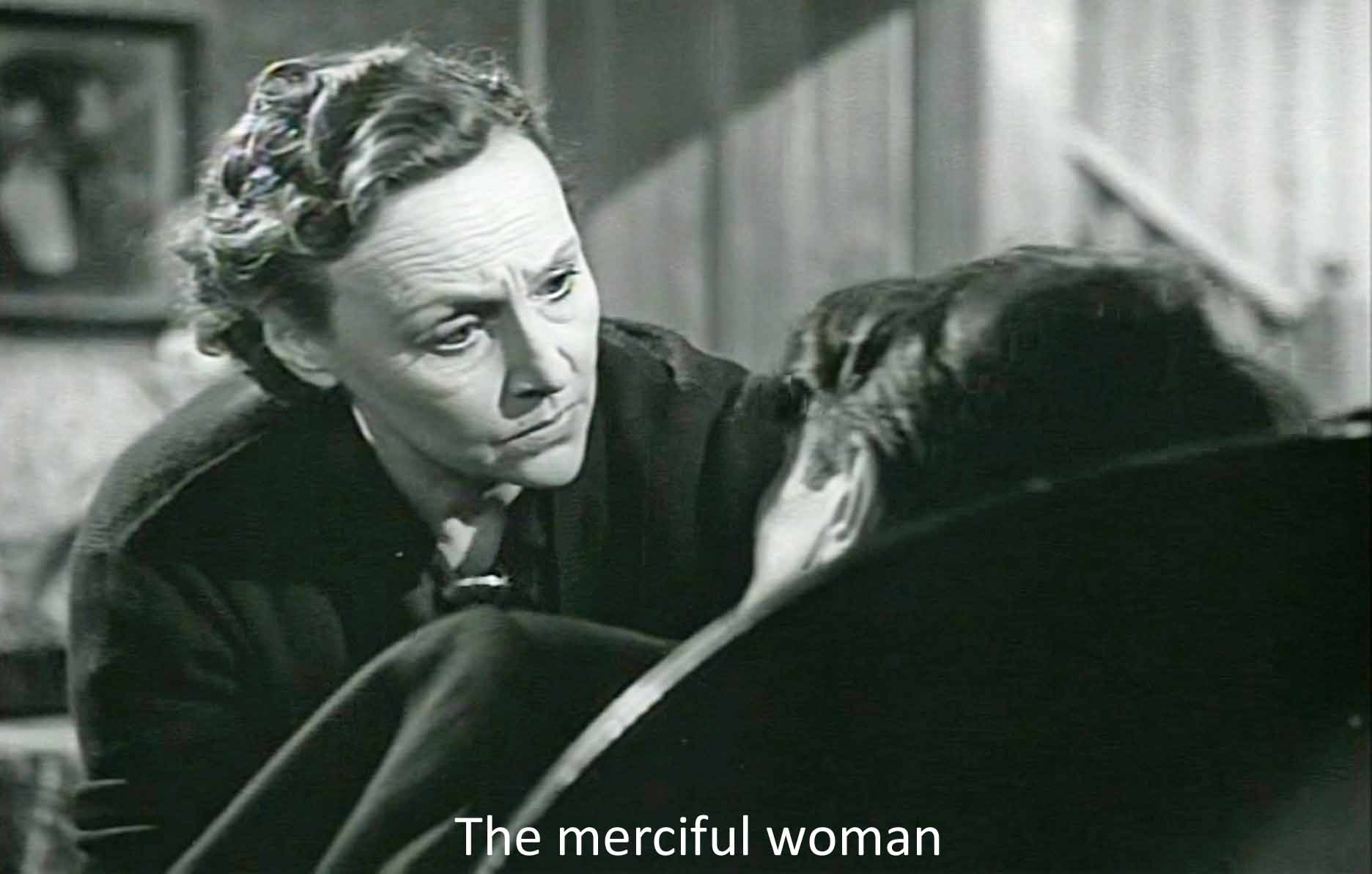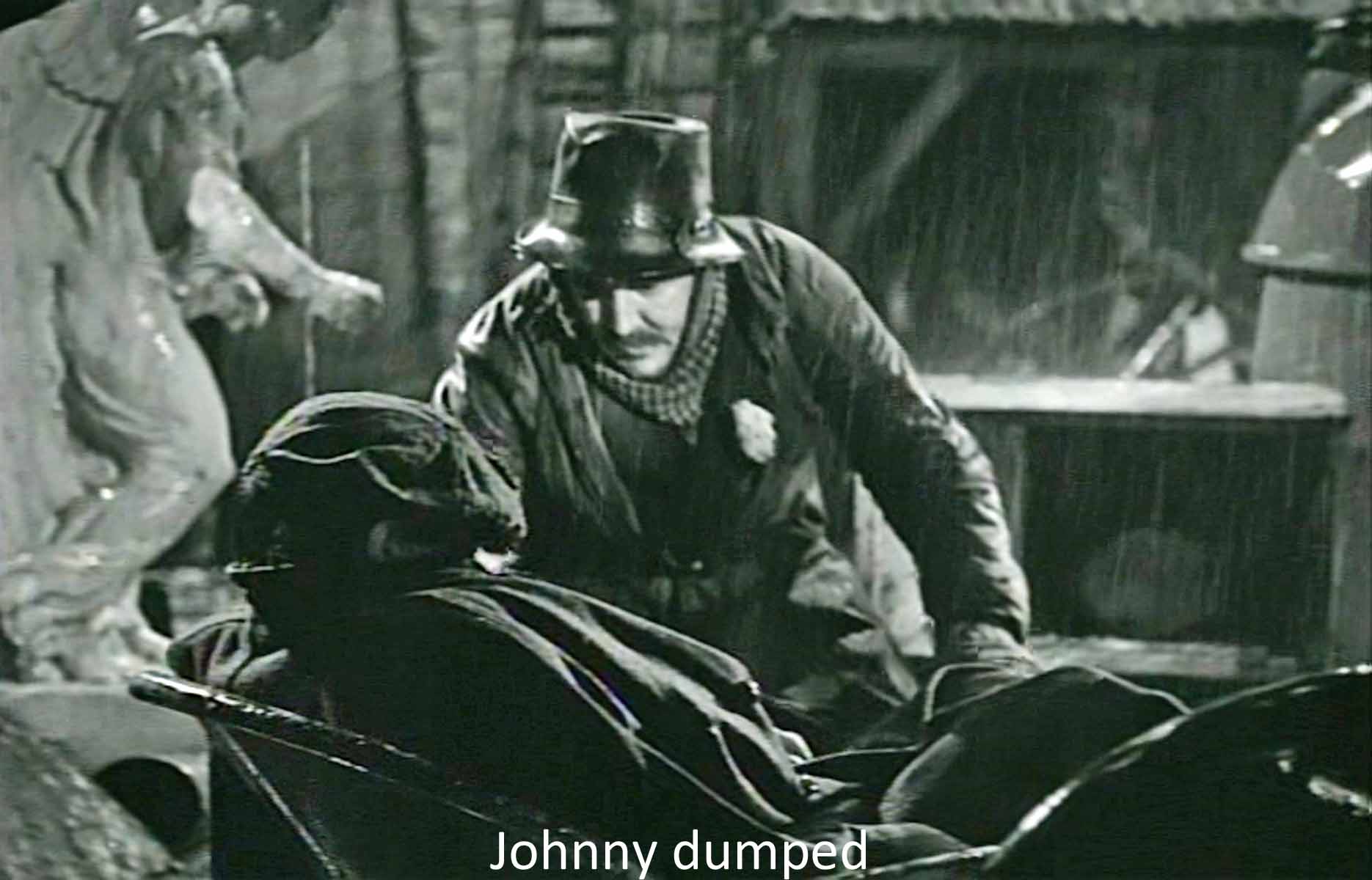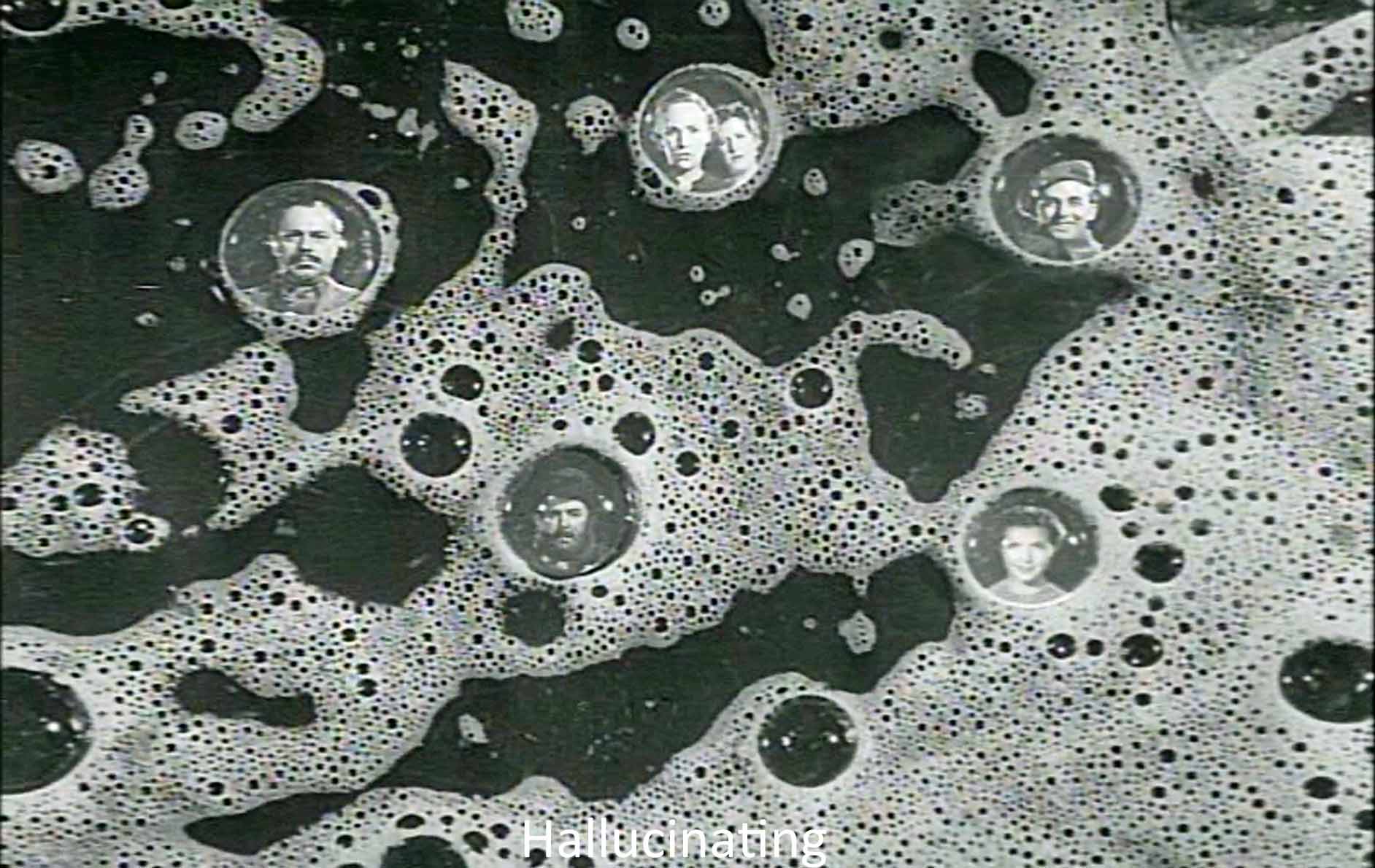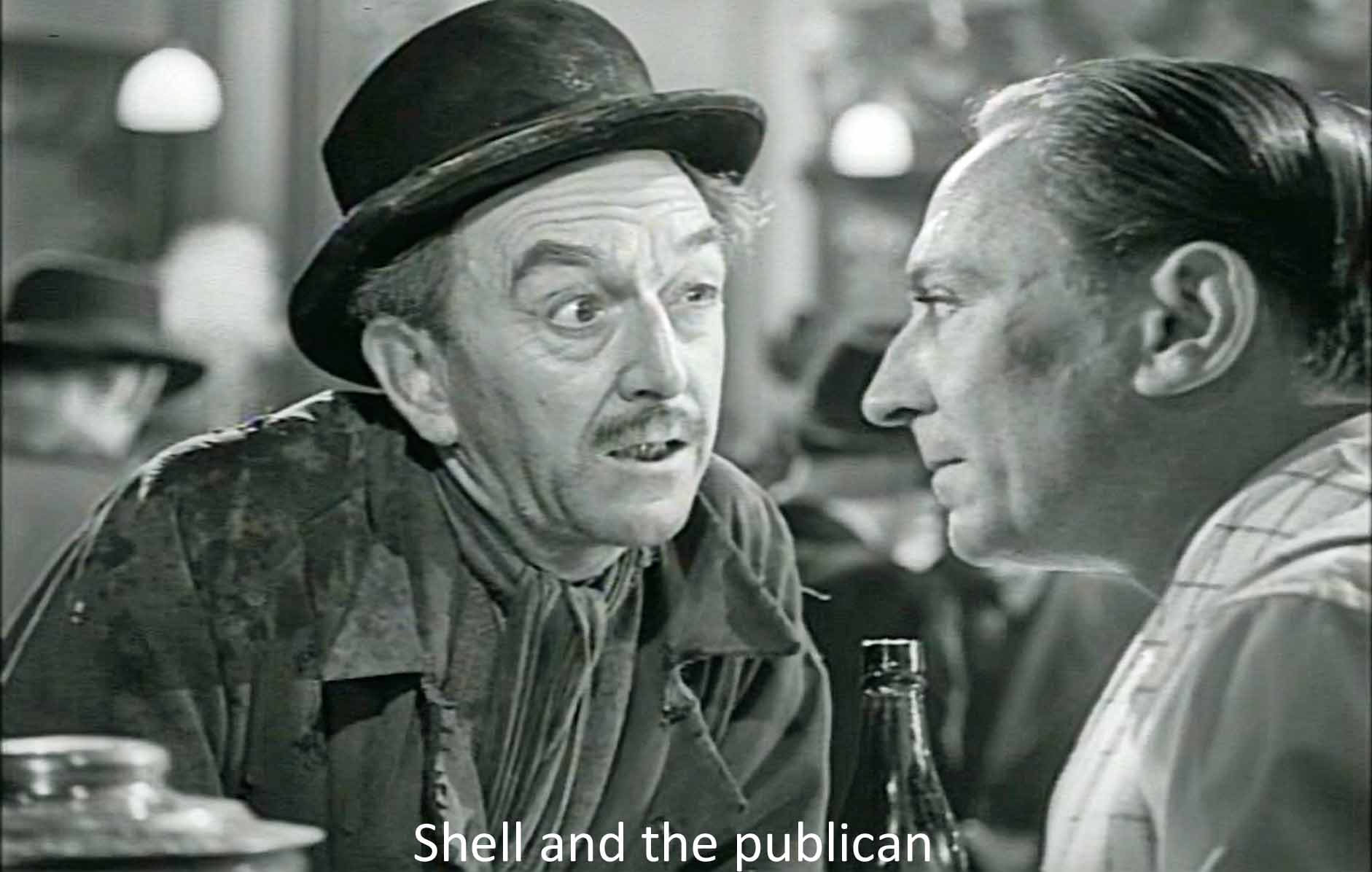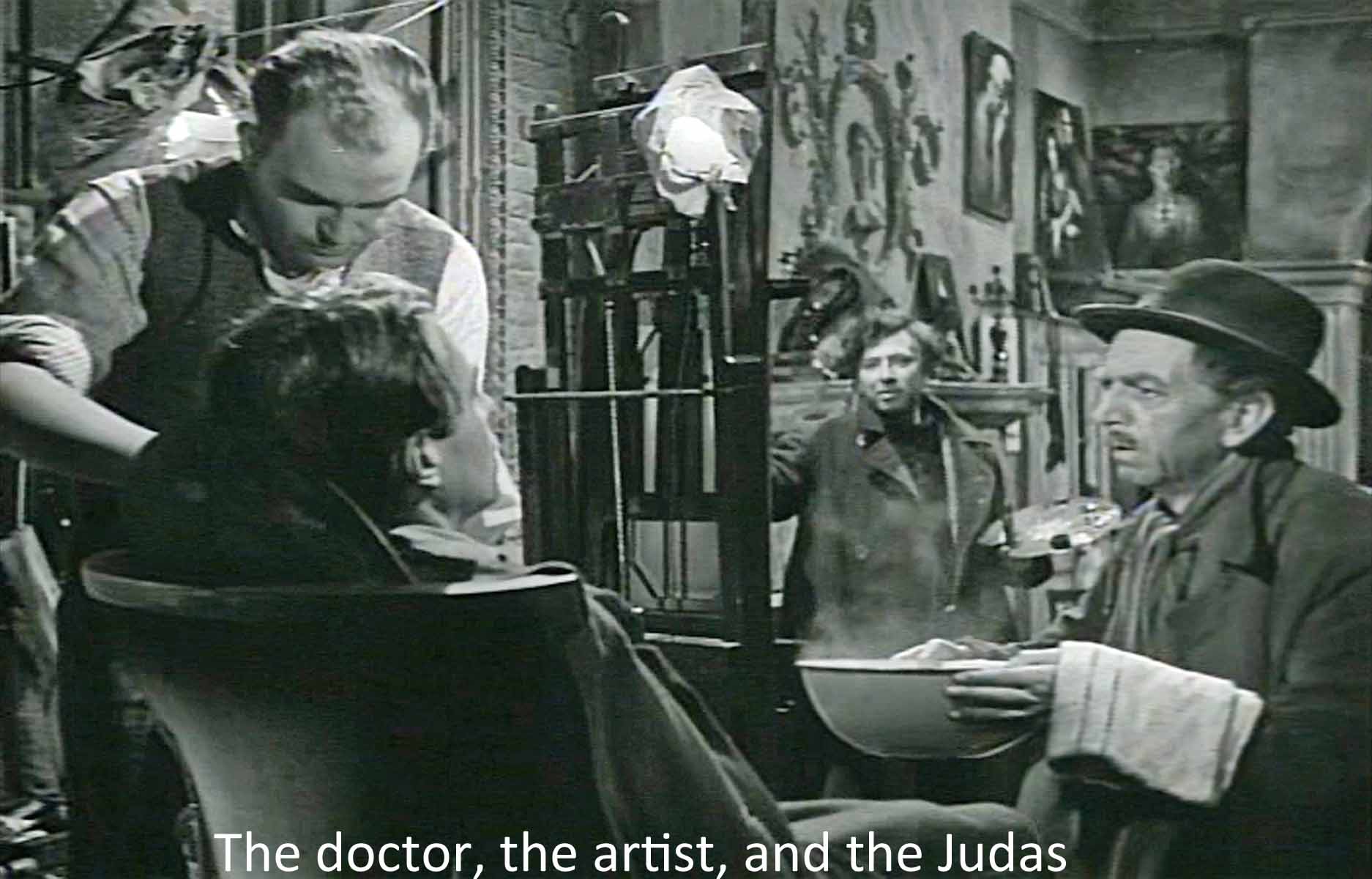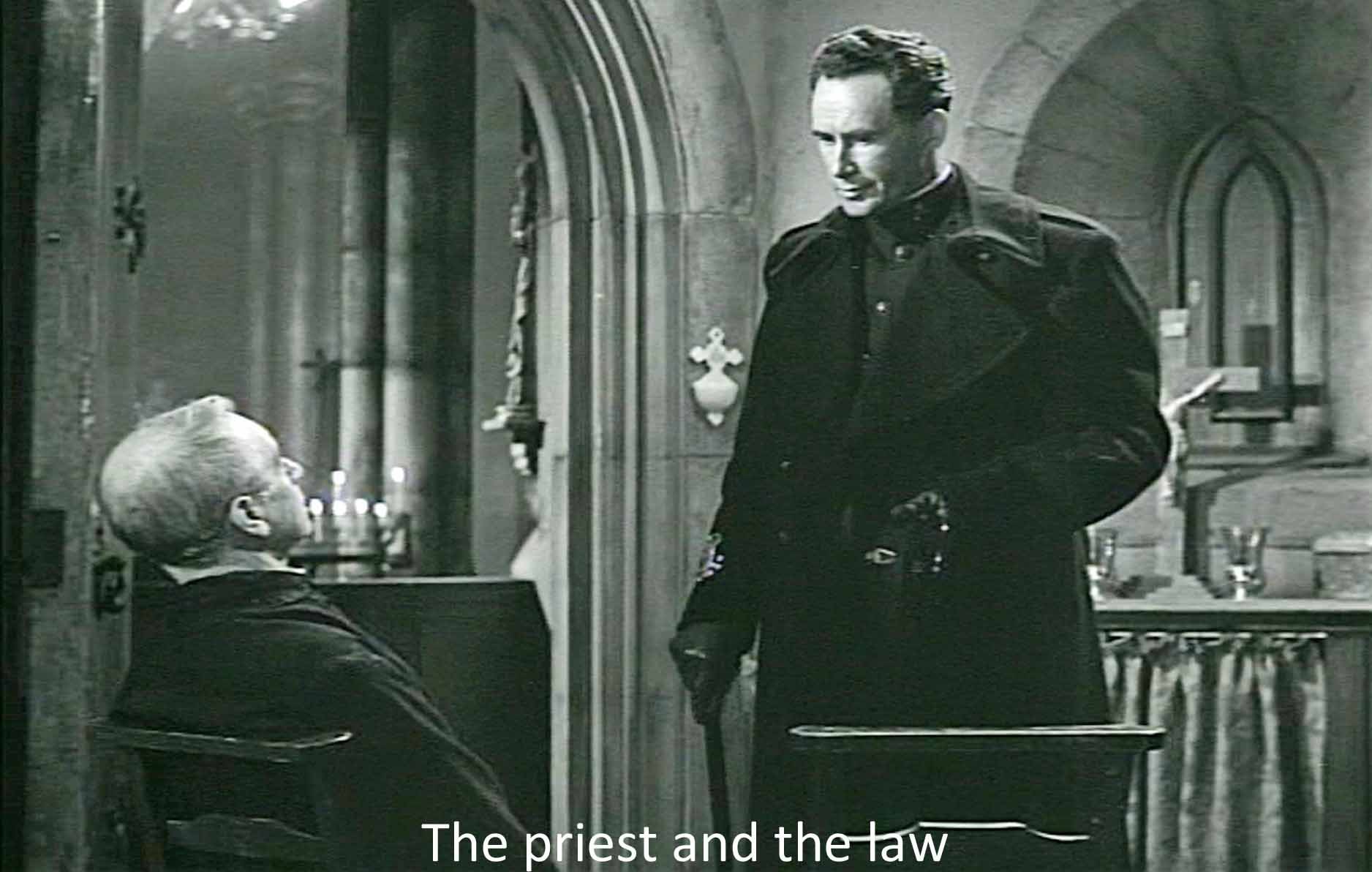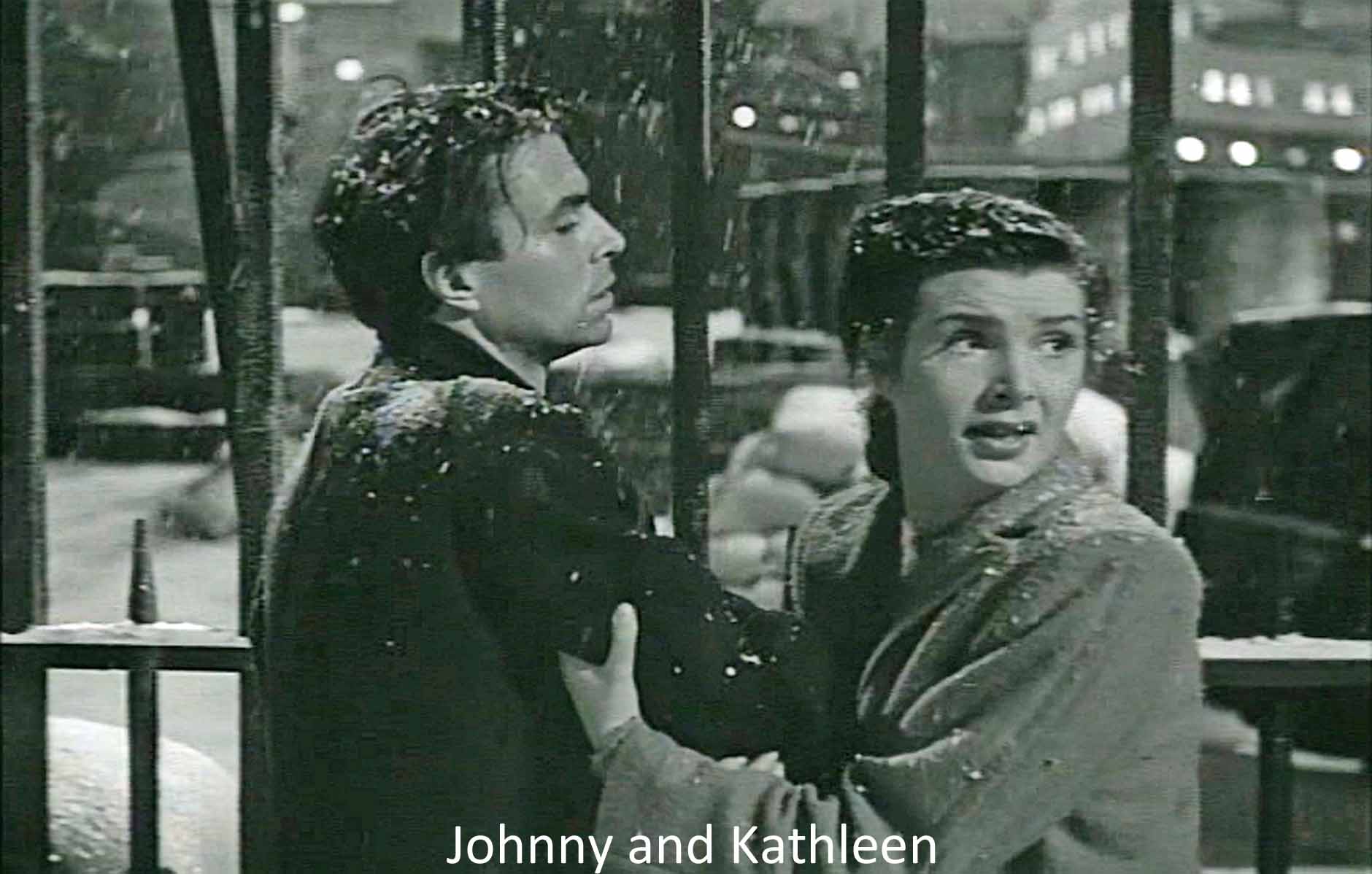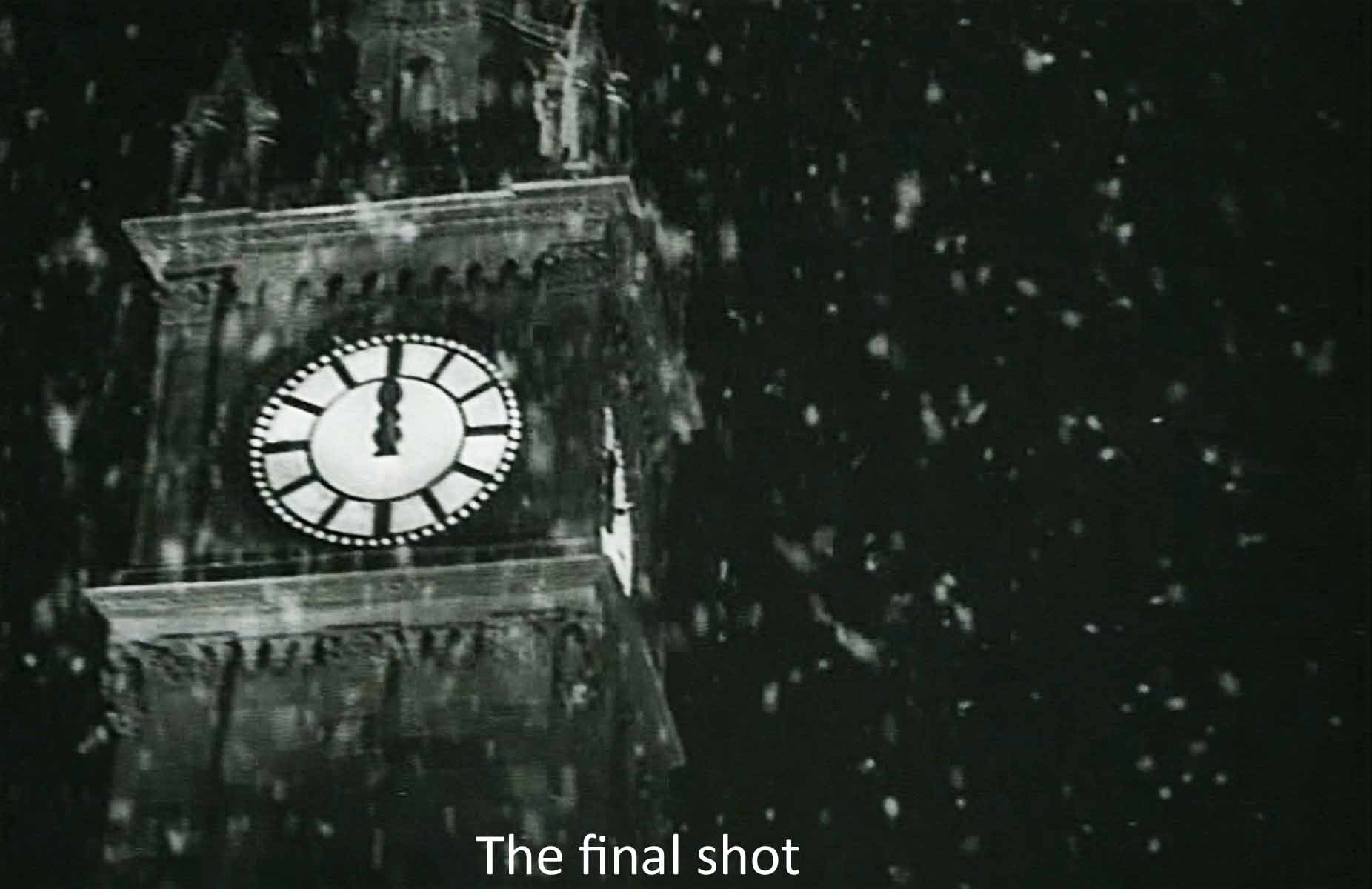Now, this is less than candid. Director Carol Reed clearly identifies the city (Belfast) by some well-known shipyards in the aerial photographs that constitute the first shot and by the shot of the Albert Tower, a Belfast landmark, that ends this sequence. And what else would the “illegal organization” so deeply infused in Belfast in 1947 be, but the IRA? Certainly the Belfast authorities knew it was, and they provided extra police for the film’s Belfast opening.
What’s going on, then? Why try to deny that this film tells a story about particular events at a particular time and place? Because this film is indeed about something else. Certainly, it’s about loyalty, a theme that runs through all Carol Reed’s major films. Reed is telling us here that his film is about more than some particular events. He is allegorizing his film. We are to think beyond the events on screen to a larger, more abstract significance. In the most general sense, Odd Man Out is about division, “the conflict in the hearts of the people when they become unexpectedly involved.” It begins with the river Lagan that divides Belfast in the opening aerial shot. It continues with disagreement among four conspiring robbers. It quickly continues when the hero, Johnny McQueen breaks a shoelace (echoed at the end when the tramp trying to help Johnny also breaks a shoelace)—ill omens both.
As Robert F. Moss points out, Reed has created a film that follows the rules for classical tragedy: unity of time (one day), place (one city), and action (one significant plot with a fated outcome). The spilling of blood should take place offstage, and here it is offscreen. But Reed has also created a film with Christian elements all through, a cross on the wall, the image of a saint, a statue of an angel, and so on. The characters discuss the nature of faith, the relation between religion and law, and the hero recites a biblical passage. Like Christ on the via dolorosa, Johnny suffers betrayal and, in the end, death. From time to time, he assumes a Christ-like posture with arms outstretched. We can think of this combination of the classical and the Christian, between punishment and redemption, as one of the divisions in Odd Man Out.
The ultimate division, though, is between what we see on the screen and how the filmmakers want us to understand it.
What we see on the screen is a conspiracy to rob a mill by four men, led by Johnny McQueen (James Mason in the part that he said was his favorite). Robbery, I suppose, assumes a division between the robber and the robbed. In the robbery, Johnny is severely wounded and the rest of the film follows his slow progress to death. He drags himself through dark streets glistening with rain and the reflections so dear to cinematographers.
But even at the planning stage, the men are divided as to whether Johnny, who has been jailed or hiding in this small house, cooped up, has the physical strength to carry out the robbery. He doesn’t and has dizzy spells at crucial moments due, probably, to his doubts about this act of violence. (Whenever this film takes us into Johnny’s mind, he is hallucinating.) Then, foolish Pat the driver (Cyril Cusack) speeds up the getaway car too quickly and Johnny falls out. The three don’t turn back to get him, and Johnny is divided from the rest. The rest of the film consists of his staggering from refuge to refuge, trying to reunite with his “friends,” until the police finally shoot him dead.
“Conflict in the hearts of the people”—yes, but these people are vividly realistic and differentiated from one another. Also, they hover between realistic individuals and universal types, the key division in this film. Many critics have described this film as an allegory, that is, a fiction in which the realistic events also stand for universal qualities. A prime example is Edmund Spenser’s The Faerie Queene [1590, 1596] with characters that explicitly stand for Chastity, Jealousy, Friendship, Courtesy, and so on. Or John Bunyan’s Pilgrim’s Progress [1678] with characters like Christian, Hopeful, and Ignorance. Allegory is a natural vehicle for religious teaching—think of Jesus’ parables—as a way to portray convey humans as dual, as divided between natural and supernatural. Here, Reed gives us a lot of religious symbols in the background, a lot of religious talk, the presence of a church and a priest countered by a policeman, and the explicit question whether Johnny belongs to the Church or the Law. All this prompts us—me, other critics—to think of it allegorically.
Most people read Johnny’s journey through the city as an analogy to Christ’s journey before his crucifixion. It is hard, perhaps, to see a man who has robbed and murdered as Christ. (But there has been a spate of books lately showing Christ was a political rebel and an enemy of the state, like Johnny.) Throughout his travails he asks if he had killed “that fellow.” Is he expressing true guilt for a terrible sin? Or is he concerned that, if he killed him, he has committed felony murder and is subject to execution? Body vs. soul again. Nevertheless, Johnny’s postures or expressions often seem Christ-like. The characters he meets seem like biblical types. And at a crucial moment he shouts out the famous agape passage from the Bible.
One could identify these semi-Biblical characters of Odd Man Out this way:
Children. Starting with the first scene, children proliferate in this film. (No Planned Parenthood in this Catholic neighborhood.) Johnny is huddled in an old air raid shelter when a child comes and looks at him. She occurs again in the picture, an identified by her one roller skate (sign of the wretched poverty in this poor Catholic neighborhood), but also her own status as an odd one out. Johnny hallucinates her into a prison guard. The child as potentiality, but also as amoral witness, lacking any loyalty. Children occur throughout, playing soccer, begging, or pretending to be Johnny and the cops and fighting. And they feature in Johnny’s biblical quotation.
The Lovers. A couple comes to the shelter looking for a place to have sex. They could care less about Johnny and quickly escape.
The Fool. This is Pat, the driver. During the planning of the robbery, he plays with a toy teddy bear like a child, and he is cocksure about his gun. He speeds the car up and drops Johnny and won’t go back for him. Frightened, he can scarcely wait to get a drink and leads another robber into the house of a woman he knows is untrustworthy. (A third disappears at this point—chance plays a part throughout.) The woman betrays them to the police who shoot and kill them both.
The Comrade. This is Dennis (Robert Beatty). It was he who offered to take Johnny’s place in the robbery, and it is he who now endangers himself to draw the police away—and is beaten and captured. “Greater love hath no man than this, that a man lay down his life for his friends.”
The Policeman. An inspector (Dennis O’Dea) leads the search for Johnny. He goes first to the house where Johnny has been cooped up, and there he is protective: he warns Kathleen who loves Johnny not to get involved, as he does again later in the church. “He belongs to the law, now.” He is a kindly man who tries to keep Kathleen from being hurt. When the priest talks faith and salvation, he answers, “ In my position, father, there is neither good nor bad. There is innocence and guilt. That’s all.”
The Traitor. This is Theresa who turns over to the police the two robbers who have taken refuge with her. She hopes for a payment.
The Merciful Woman. Thinking him hit by a car, Maudie picks Johnny up from the street, but she too is divided. She is proud of the first aid knowledge she has acquired and shows it off. But she is also simply kind. And helpless. She doesn’t want to get involved, but she doesn’t want to send Johnny out into the rain, either.
The Unmerciful Man. Her husband is the opposite, unfeeling, unthinking, unmerciful. He just wants his tea and not to be involved.
The Man of Two Minds. Johnny gets dumped (by drunken British soldiers!) into the back of a hansom. The cabbie “Gin” (Joseph Tomelty) doesn’t realize Johnny is in his cab. When he finds him, he dumps him in a junkyard (with an angel statue looking down on him). He tries to have it both ways: “I’ll soon get the heads and tails of this.” “I’m not for ya, I’m not against ya, but I can’t afford to get mixed up in this.” “If you get back to your friends, you’ll tell’em I helped ya.” “But If the police get ya, ya won’t mention my name, huh?”
The Judas. Shell (F. J. McCormick), a half-crazy derelict, spots Johnny in the junkyard, realizes who he is, that there’s a reward, and he tries to sell Johnny. “He goes to the right buyer.” In another example of allegory, he tells a story of a sick bird—he has birds for pets and he is carrying one with him—to tell the priest about Johnny without telling him things it would be criminal of the priest to know. Shell (fragile, hollow) accepts the priest’s promise of faith as payment instead of cash. He keeps trying to hold onto Johnny until Kathleen finally reaches him at the end of the film.
The Priest. Father Tom ((W. G. Fay) wants Johnny, but he wants him in order to bring him back into the faith. Kindly and appealing as he is, like all the others, he wants to fit Johnny into his own interests: the church and the faith. His talk of faith and salvation and such further heightens the allegorical feeling.
The Publican. Johnny stumbles into a pub owned by Fencie (William Hartnell) who quickly conceals him in a “snug.” A commotion breaks out in the bar, and Fencie moves the clock up so he can announce closing time. In the booth Johnny spills his beer and sees surreally in the bubbles on the tables the faces, jabbering, of those who have helped or hindered him. Once the bar is closed, Fencie hustles Johnny off with Lukey, the artist.
The Artist. Lukey (Robert Newton) shares a slum with Shell and paints religious pictures. Here the religious theme becomes very strong. This bizarre man wants to paint the dying Johnny because his soul will show through. Lukey: “There’s something to be said about him before he dies. . . . . I understand what I see in him. . . . . It’s the truth about us all.” It is while he is sitting for Lukey that Johnny stands up and shouts out what could serve as the “moral” of this densely moral movie. ;When I was a child, I spake as a child, I understood as a child; but when I became a man, I put away childish things.” Now we can understand the presence all through of children: they point to adults who have not put aside their childish selfishness. Then, “Though I speak with the tongues of men and of angels . . . though I have the gift of prophecy and understand all . . . knowledge . . . and have not charity, I am nothing” (1 Cor. 13: 11-12, followed by 1-2). It is charity that wounded Johnny seeks and needs and does not find in “the hearts of the people” who use him for their own purposes, who close their doors and windows—and hearts—as he passes. Dennis says, “He’ll belong to the Organization.” The Inspector: “He belongs to the law now.” Lukey: “I want him.” And even Kathleen: “Let me have him.”
The Doctor. A third resident in Shell’s and Lukey’s slum is Tober (Elwyn Brook-Jones), a onetime medical student. He patches Johnny up, but he wants to take him to a hospital. That would, of course, turn him over to the police, but the doctor doesn’t care: “I can’t help what happens to him later.” The scientist and the artist battle over who shall have him. Is he merely a body as the doctor would have it or is he the soul that Lukey sees in him? As they argue, Shell manages to get Johnny away from the crazed and drunken Lukey and tries to get him to Kathleen. But when the police appear he has to leave him lying in the falling snow.
The Lover. All along Johnny has been trying to get to “his friends,” among them Kathleen (Kathleen Ryan). It was clear from the first scene that she loves him, and she tells Father Tom that she wants to commit suicide with him to save him from the gallows. The priest, of course, disapproves of this—he has his own agenda. But Kathleen does find Johnny. She has arranged for him to escape on a ship if he can get to it by midnight—her agenda. They are on their way when the police catch up to them. Kathleen fires at them, and they shoot back at Johnny and her, killing them both. “Suicide by cop” we have learned to call this in our gun-plagued land. But again, “Greater love hath no man than this, that a man lay down his life for his friends.” Both the inspector and the priest preside at the death, the secular and the spiritual.
In a clever dissertation, Matthew Dwight Moore points to the importance of time. Odd Man Out begins and ends with a shot of the Albert clock tower and this is a film filled with clocks. The action starts with the chiming of 4:00 p.m. The bells ring during the robbery, and there is a clock on the wall in the mill. When cabbie “Gin” dumps Johnny, the clock tolls 8:00. The film ends with the chiming at 12:00 midnight. The clock has defined the action as lasting exactly eight hours, as if the story of Johnny is an ordinary workday or a sailor’s watch (“the truth about us all”). But, of course, although we are all journeying toward death (as the ex-medical student points out), there is nothing ordinary about Johnny’s journey to death.
Moore shows that time occurs two ways in this film, clock time, “mechanical,” or “cosmological” time defined by the sun and moon and stars. We hear the bell tower chiming the hours all through the film. During the robbery, the robbers time their moves in the mill exactly by the clock, and there is a clock on the wall. We see clocks in the pub when the owner sets the clock ahead to clear the revelers out. Kathleen had planned an escape for Johnny by ship and the time for that was defined both by the cock and by the tide—cosmological time in Moore’s term. And, of course, the whole allegorical feel of the movie combines the time-bound natural world with timeless supernatural abstractions like guilt or redemption.
That is the most profound division, the one dramatized in the scene between the artist and the doctor. The characters are divided between being simply humans as humans and as archetypal players in a drama of sin and salvation. That, I think, is what makes this film so much more than a simple suspense movie. It touches on our very nature as human beings, that we are flesh and blood primates—mere animal life—but we are also beings with a moral dimension beyond time and our animal nature.
The film’s music dramatized that division. William Alwyn, working with Reed from the start, composed the score for the film before the shooting. (Mason had to time his walking to the music.) Moss points out that Alwyn used different leitmotifs for the different characters: a bird-like tune for Shell; a romantic lyric for Kathleen; and a threnody for Johnny. This way Reed again gives the characters two different dimensions, visual/physical and musical.
Cinematographer Robert Krasker came to this film after fine work on Olivier’s Henry V (1944) and Lean’s Brief Encounter (1945). Here, Michael Sragow writes for the Criterion DVD, Krasker
fills his nightscapes with wraithlike shadows and dazzling illuminations. He achieves amazing depth of field without the sharp, clean contours we associate with depth of focus; draping Reed’s people in mists or spotting them in streetlights and headlamps, outlining them in doorways or profiling them against window shades, Krasker conjures an atmosphere that a viewer’s eyes sift excitedly.
Yes, the music and the camera work and the acting and the director’s decisions are all fine.
To me, though, what makes this film special is the mysterious quality that cues me (and many other critics) to see it as allegorical. The first move in that direction comes with the crawl insisting that we not read the film realistically. Then at the robbers’ planning session, Johnny makes a little speech about the way his prison experience led him to doubt the wisdom of such violence. Still later, after Johnny, wounded, has hidden in the shelter, a ball bounces in and the little girl with one roller skate comes in to get it. Johnny hallucinates (happily!) that the shelter is his jail cell and the girl is a prison guard, reminding me of his talk about the way his thinking in prison turned him against violence. Clearly, by this time, the film is telling me to give Johnny’s situation a more abstract significance. And, finally, that significance comes through loud and clear when Johnny shouts out the agape verses from 1 Corinthians, and Lukey and the doctor discuss his soul. This is not your usual heist movie.
Director Carol Reed was supported by working in one of the high periods of world cinema, British films of the mid-1940s to early 1950s. Think just of: David Lean’s Brief Encounter (1945), Great Expectations (1946), and Oliver Twist (1948); MD-DN Powell and Pressburger’s A Matter of Life and Death (1946), Black Narcissus (1947) and The Red Shoes (1948; Laurence Olivier’s Henry V (1944) and Hamlet (1948); the Ealing Studios’ comedies like Kind Hearts and Coronets (1949), The Man in the White Suit (1951), and The Lavender Hill Mob (1951). Even among these gems, Odd Man Out along with Reed’s other great films, The Fallen Idol (1947), and The Third Man(1949) stands out.
